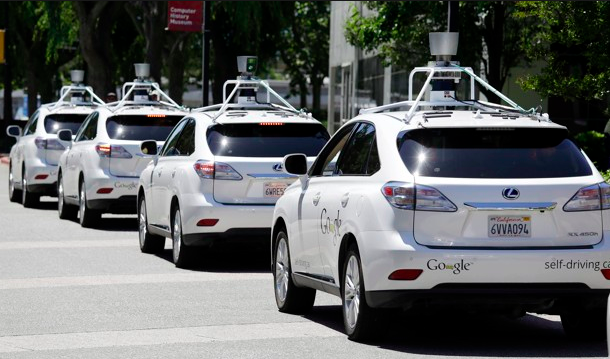The article below appeared in Local Transport Today 699, 10 June 2016. It was prompted by discussions at a workshop event organised by colleagues at the Transport Institute of University College London, who are carrying out a study for the Department for Transport of social and behavioural impacts of autonomous vehicle.
There is much interest in the possibilities for autonomous vehicles, in particular driverless cars. Focus is mainly on technological feasibility, role of the driver, risks and insurance. What has not yet been sufficiently considered is the implications for traffic. How much difference would autonomous vehicles make?
There are two broad routes to driverless cars. Mainstream auto manufacturers are equipping vehicles with devices that assist the driver. Adaptive Cruise Control automatically adjusts the vehicle speed to keep a safe distance from the vehicle ahead. Lane Keeping systems alert the driver if the car is drifting out of its lane and assist in steering back. Self-Parking systems allow a vehicle to park hands-free. Such devices are contributing to a reduced role for the driver, which ultimately could lead to driverless vehicles. The crucial transition is from high automation to full automation. Because many manufacturers, BMW for instance, market their cars on performance, they are likely to encourage hands-off-the-wheel only in situations where there is little challenge to the keen driver – such as long motorway trips or slow-moving urban traffic. Otherwise, driving is to be enjoyed.
Google’s pods, lacking a steering wheel, exemplify the other route – the great leap forward to full driverless. While these electric vehicles could be privately owned, they seem particularly suitable for shared ownership, given that they are, in effect, taxis with robot drivers. Taxis are popular, and we would make more use of them if they were cheaper, which they might be if robots replaced humans. This could increase demand, adding to traffic congestion in urban areas. But possibly the technology might allow the safe distance between moving vehicles to be reduced, packing more into the available carriageway.
The main impact on traffic of shared driverless cars is likely to be via parking. Privately-owned cars are generally parked for 95% of the time, seemingly an inefficient use of resources. Sharing would allow more time in use and so fewer parked cars. But the main impact on road space would be in the suburbs and car parks, not city centre streets where congestion is most acute and where parking is limited to avoid impeding traffic.
Driverless vehicles would contribute to congestion when they are on the move empty, as do black cabs plying for business. Programming your personal driverless car to cruise round the block empty while you transact business in a shop – in effect ‘parking’ on the move – would need to be regulated, possibly banned, in city centres (although this could lessen the attractions of driverless vehicles). A two-car family might economise with one driverless car, taking the breadwinner to work, then returning for use by the house wife/husband and children, before collecting the worker at the end of the day. But this would double the number of work trips, adding to traffic.
Altogether, it seems likely that the overall impact of driverless cars would be to increase urban traffic. It would be desirable model traffic flows under a variety of driverless scenarios to understand better the implications, since there may be conflicting policy objectives.
The UK Government is keen on driverless cars. The ministerial introduction to the Department for Transport’s 2015 action plan, The Pathway to Driverless Cars, starts: ‘Driverless vehicle technology has the potential to be a real game changer on the UK’s roads, altering the face of motoring in the most fundamental of ways and delivering major benefits for road safety, social inclusion, emissions and congestion.’ The Chancellor of the Exchequer, in his 2016 Budget, made a point of announcing trials of driverless cars on the Strategic Road Network by the end of 2017.
It could turn out, however, that benefits of autonomous vehicles on inter-urban roads could be offset by increased traffic on urban roads. One way of mitigating such traffic would be to increase vehicle occupancy significantly. This may be possible though what might be termed the ‘shared-squared-driverless’ mode, involving both shared ownership and shared use.
So rather than one or two occupants, the aim would be to fill the vehicle at peak times with passengers travelling in the same direction. This would reduce urban traffic congestion through high occupancy requiring fewer vehicles, with one study suggesting that this could remove 9 out of 10 cars in a mid-sized European city. Uber has introduced uberPool, a shared taxi service with lower fares, and uberHOP, which facilitates sharing along commuter routes at peak times. Their success will depend on the ability to match enough passengers going in the same direction, and also on the willingness of people to share.
If priority were given to shared-squared-driverless vehicles through road pricing or similar demand control measures, it might be possible to avoid urban traffic congestion while offering speedy and reliable door-to-door travel. This would be facilitated by some central oversight of such vehicles to minimise conflicts and maximise efficient use of the road network (analogous to air traffic control). The outcome could allow the car to compete with rail in urban areas, in terms of speed and reliability, and could help cities without rail infrastructure better to meet the mobility needs of their citizens. However, the technological, institutional and commercial challenges to the shared-squared-driverless concept are substantial, and practical feasibility is unclear.
Colin Buchanan’s seminal report, Traffic in Towns, was published 50 years ago, decades before the possibility of driverless cars. How much difference would autonomous vehicles make to urban traffic congestion? In the medium term, congestion could worsen, unless action were taken to regulate the movement of vehicles without occupants. In the longer term, the possibility of higher vehicle occupancy offers the prospect of mitigating urban traffic congestion.

